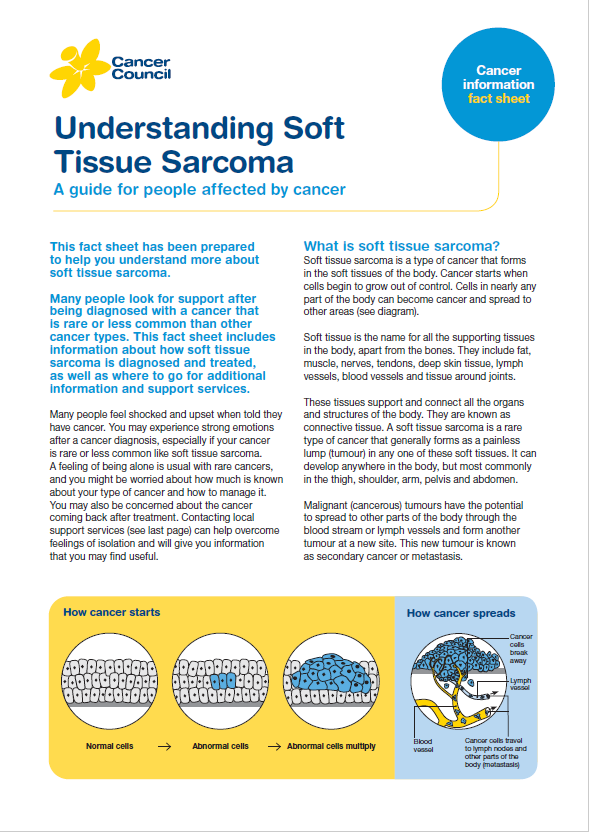- Home
- Soft tissue sarcoma
- About soft tissue sarcoma
About soft tissue sarcoma
Soft tissue sarcoma is a type of cancer that forms in the soft tissues of the body. Cancer starts when cells begin to grow out of control. Cells in nearly any part of the body can become cancer and spread to other areas.
Learn more about:
- What is soft tissue sarcoma?
- The types of soft tissue sarcoma
- Who gets soft tissue sarcoma?
- What causes soft tissue sarcoma?
What is soft tissue sarcoma?
Soft tissue is the name for all the supporting tissues in the body, apart from the bones. They include fat, muscle, nerves, tendons, deep skin tissue, lymph vessels, blood vessels and tissue around joints.
These tissues support and connect all the organs and structures of the body. They are known as connective tissue. A soft tissue sarcoma is a rare type of cancer that generally forms as a painless lump (tumour) in any one of these soft tissues. It can develop anywhere in the body, but most commonly in the thigh, shoulder, arm, pelvis and abdomen.
Malignant (cancerous) tumours have the potential to spread to other parts of the body through the blood stream or lymph vessels and form another tumour at a new site. This new tumour is known as secondary cancer or metastasis.
Types of soft tissue sarcoma
There are more than 70 types of soft tissue sarcoma. They are named after the abnormal cells that make up the sarcoma, that is the type of cell where the cancer first started to grow.
The most common type in adults is undifferentiated pleomorphic sarcoma (UPS), which is made up of many abnormal spindle-shaped cells. It is aggressive so it often returns or spreads after treatment.
Other types of soft tissue sarcoma
Adults | ||||
| Liposarcoma | from fat cells | |||
| Leiomyosarcoma and rhabdomyosarcoma | from muscle tissues | |||
| Angiosarcoma | from blood and lymph vessels | |||
| Malignant peripheral nerve sheath tumour (MPNST or PNST) | from the lining of nerve cells | |||
| Gastro-intestinal stromal sarcoma (GIST) | from nerve cells in the gut (treated differently from other types of soft tissue sarcoma) | |||
| Stromal sarcoma | from supporting tissues | |||
| Kaposi sarcoma | from skin cells | |||
Children and young adults | ||||
| Rhabdomyosarcoma | from muscle cells | |||
| Ewing sarcoma | (may also start in the bone) | |||
| Synovial sarcoma | from cells around joints and tendons | |||
More information on the different types of soft tissue sarcoma is available from the Australia and New Zealand Sarcoma Association (ANZSA) and Rare Cancers Australia.
Who gets soft tissue sarcoma?
Soft tissue sarcoma is rare. Around 1600 Australians are diagnosed with a soft tissue sarcoma each year (about 6 cases per 100,000 people). It is slightly more likely to be diagnosed in men than women.
While soft tissue sarcoma can develop at any age, it is more likely to be found in people over 55 years of age.
What causes soft tissue sarcoma?
The causes of most sarcomas are not known. However, there are several risk factors:
Radiation therapy
There is a very small risk for people who have had radiation therapy (also known as radiotherapy) to treat other types of cancer. The risk is higher for people who had high doses of radiation therapy at a very young age. Most people who have had radiation therapy in the past will not develop soft tissue sarcoma.
Genetic factors
Some rare, inherited conditions can put people more at risk of soft tissue sarcoma. These rare, genetic conditions include von Recklinghausen disease (also known as neurofibromatosis or NF), Li–Fraumeni syndrome (also known as p53) and retinoblastoma (also known as Rb). Most people know if one of these very rare conditions runs in their family, and if so, that they may pass it to their children.
If you do not know of this condition in your family, then it is very unlikely that it is present. A small number of people develop sarcoma due to genetic changes that happen during their lifetime, rather than inheriting a faulty gene.
Chemicals
Some sarcomas may be linked to being exposed to chemicals including vinyl chloride (used to make plastic) and some high-dose herbicides (weedkillers).
Other
Long-term lymphoedema in the body, for example in the legs or arms (swelling from a build-up of lymph fluid) has been linked with angiosarcoma.
→ READ MORE: Soft tissue sarcoma symptoms
Dr Susie Bae, Medical Oncologist, Peter MacCallum Cancer Centre, VIC; Tony Bice, Consumer; Dr Denise Caruso, CEO Australian and New Zealand Sarcoma Association, VIC; Emma Gardner, Nurse Coordinator, Bone and Soft Tissue Unit, Peter MacCallum Cancer Centre, VIC; Jonathan Granek, Consumer; Thelma Lobb, Consumer.
View the Cancer Council NSW editorial policy.
Need to talk?
Support services
Coping with cancer?
Speak to a health professional or to someone who has been there, or find a support group or forum
Need legal and financial assistance?
Pro bono services, financial and legal assistance, and no interest loans
Cancer information
What is cancer?
How cancer starts and spreads
Resource hub
Guides, fact sheets, videos, podcasts and more for people with cancer, their families and friends
